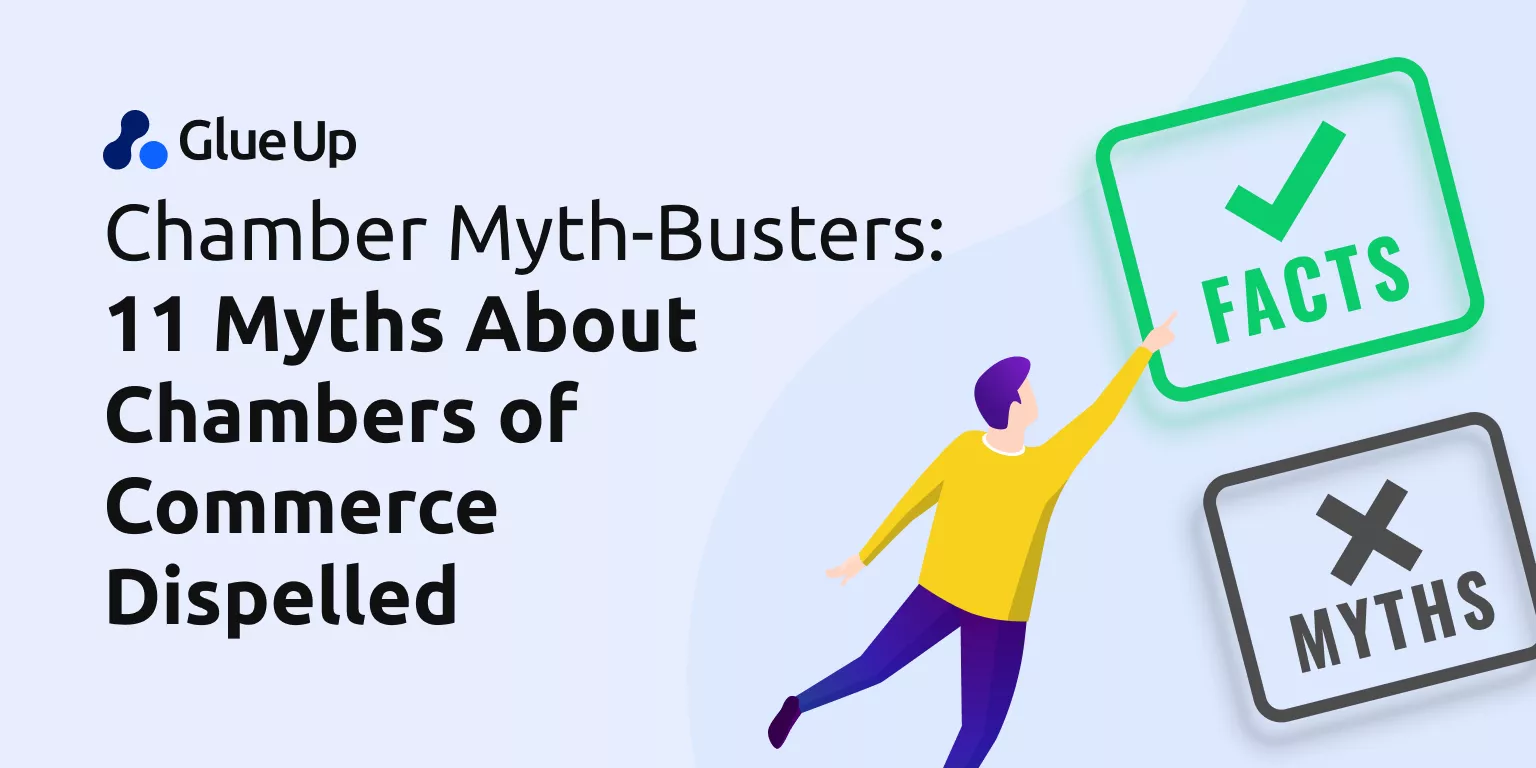
The common idea about a Chamber of Commerce is that it’s a group of over-paid, senior, crotchety old men and women that pat themselves all on the back and do business with each other. It’s been a huge misunderstanding about what chambers of commerce stand for, and who they’re comprised of for the longest of time, and it’s myths and prejudiced ideas of chambers of commerce are only helping to maintain their composure.
In fact, Chambers of Commerce offer far more than you might expect. So we’ve decided to dispel a few common myths and preconceptions of chambers of commerce so you don’t get the wrong idea.
Key Takeaways
- Contrary to popular belief, most chambers are independent, profit-seeking organizations, not government-run agencies.
- Many chambers actively recruit younger professionals through mentorship programs, challenging the stereotype that they are only for older business leaders.
- Beyond networking events, chambers provide services like mentorship, professional development, and advocacy, benefiting both businesses and non-profits.
- While chamber memberships can seem costly, the value comes from active participation, networking, and the potential business growth members can achieve.
- Glue Up’s all-in-one management platform enhances member engagement, streamlines operations, and supports chambers in delivering more value through tools like event management, CRM integration, and automated invoicing.
1. They’re a part of the government

While the name is U.S. Chamber of Commerce, it is actually a long-standing PAC that engages in direct politics in the U.S.. In reality it is not a real chamber of commerce as you're used to seeing.
One of the biggest misconceptions about chambers of commerce is that they’re a part of the government. In fact most chambers of commerce around the globe are not part of any government and are self governed, profit-seeking organizations that make profits through membership dues and events, like any other company.
This misconception is largely due to that fact that a lot of governments will have departments or agencies called “The” Chamber of Commerce, like the U.S. Chamber of Commerce, in which it is not actually a chamber of commerce, but actually a political action group which directly deals with lobbying, something no real chamber of commerce does, and so it can often times make local chambers of commerce seem political, when in actuality, it is not.
Chambers of commerce are more properly businesses themselves, who’s core value is the support provided to local, regional, or national businesses depending on their intended strategy, or in other cases to direct industries or demographics, we'll get into this a bit later.
2. It’s only for senior level professionals
Another large misconception that is becoming a hindrance to the growth of chambers of commerce is that it’s mostly made up of older or retired business owners, execs or professionals. This is not the case however, and most chambers of commerce are looking for members of all ages to breathe fresh ideas into the chamber. The Canadian Chamber of Commerce in Hong Kong has launched specific marketing campaigns to target young professionals just out of university to bring more young members in via their mentorship programme.
This has opened new avenues for membership types as well for chambers seeking new channels of funding, where members instead of becoming a collaborative individual in the chamber, are instead taken in as mentees where more senior chamber members can mentor younger chamber members to help with their career growth.
3. Chambers are boring

In a bid to reach younger professionals, the annual gala promotion at CanCham Hong Kong has taken on vibrant color schemes and clearly reaches a younger audience to incentivize younger members to join.
Chambers have a general image of being a boring, aged, and antiquated form of doing business. In a world where digital and speedy, exciting ways of doing business are more preferred, this concept of a boring, boardroom style business can be a turn off for professionals seeking the “new” thing.
This can sometimes be true for older chambers not willing to make the jump into technology, new industries, or generally mixing it up. But the reality is that change is necessary for success in any business, and chambers of commerce are like any other business, and if you were to look under the skin of most chambers, you’ll find events, networking, and committees dedicated to what piques your interest.
Chambers of commerce also elect their own leadership in frequent periods, so generally speaking chambers should be shaking things up with new leadership taking the chamber in new directions with new types of events being experimented with and new members churning into the chamber.
4. They’re just for networking
Chambers of commerce from the outside looking in, you can see that it’s most common activity is hosting events, mostly for networking or helping to sponsor business-friendly events in the area. This is however just what the chamber does on the surface since it’s the most visible activity that they are entrenched in.
In reality chambers of commerce, particularly larger ones, will have different services for members and even sometimes non-members depending on the chamber’s resources available. Consultations are typically provided to business members as likely the second most popular activity that goes on behind closed doors at chambers, with other services like the aforementioned mentorship programmes, professional coaching, and even marketing & advocacy services for members. Some chambers of commerce even offer courses for professional development with certificates.
5. Chambers are not for Non-Profits

Non-profits are organizations that have overhead like any other business. If you’re an NGO reading this, we don’t need to tell you that running an NGO is like running any other business. And so the myth that Chambers only serve profit-making companies is unsubstantiated.
NGOs have budgets and need to spend money to help grow their organization as if it were a company like any other, and if joining a chamber of commerce is decided to be in it’s best interest, you would likely catch more than a handful of chambers of commerce with NGOs and charities as members benefiting from the networking and other member benefits that a chamber could provide to an NGO.
6. Membership is too costly
Chambers of commerce can seem pricey since the average costs of an individual membership is around $400, to $600 annually at smaller chambers, and upwards of $5000 per year for larger or statewide chambers. But this is just scratching the surface of “costly”. How much does being a member bring business to you as a professional or a business member? Has one good networking connection brought in more $$$ than the cost of your membership?
As well, joining chambers of commerce as corporate members may unlock a limited or even unlimited number of member-level access for your employees to attend events hosted by the chamber, spreading the cost of the membership among employees that drive down the per-head cost of joining as a corporate member.
However just joining a chamber does not mean you’ll reach ROI magically. Chambers of commerce require cooperation, engagement, and active members giving feedback and participating to make it work. It only works if you work it.
7. Chambers only care about local businesses

The US Women's Chamber of Commerce is an example of a chamber of commerce that's not region-specific.
This is untrue. While local chambers of commerce are plentiful, it can seem like most chambers are focused on local businesses and challenges simply because every town, city, state, province, etc has a chamber that helps the region.
What you might not know is that larger chambers in your area are actually quite national, or even global. Chambers understand that a local business these days highly-likely has customers and employees around the globe, and are partnering with chambers abroad using "chamber passports". These are effectively a right for you, a member of your local chamber in the US for instance, to enjoy the rights as a member at other chambers abroad like your local American Chamber of Commerce in China, Brazil, UK, and so on.
So if you're a frequent business traveller, you might want to consider how much support a membership at your "local" chamber might actually provide you during your travels.
In fact, chambers can bridge industries and demographics that might actually pertain to your professionally or career-wise better than a local chamber, especially if your business makes your travel or work with clients that stretch farther than your home country. Some instances might be the U.S. Women’s Chamber of Commerce, the National Black Chamber of Commerce, and the Africa Energy Chamber of Commerce to name a few chambers that buck the localization trends traditional chambers have.
8. It’s made up of volunteer staff
This is a sneak peak into the Greater Omaha Chamber of Commerce offices. At Glue Up we visit our chamber clients often and their offices are increasingly taking a new on a shared-office vibe.
There’s a myth that Chambers of Commerce are made of volunteers businesspersons working as if it was an NGO asking for donations and so on. In reality chambers as we’ve said before, are like businesses, and the only thing that’s different, is that there is a voting structure for a chamber’s board of directors (rather than shareholder based ownership seating in the board).
Once a board is voted in, it’s time to hire a new CEO/President/Executive Director of the Chamber, and the staff needed to support it’s activities. Staff and offices of chambers of commerce are often times reminiscent of typical offices, because, it is again, like any other business and requires a full time staff and the proper offices to run the organization’s hundreds of annual events, meetings, and proper admin work needed to manage it’s memberships, finances, and services.
We hope that his has dispelled a few preconceptions you had yourself about chambers of commerce, or even just learned something new about chambers you didn’t know before. Chambers of commerce are struggling to buck these mis-interpretations that they’re antiquated and like any free-market entities, are rapidly changing their activities, structure, and services to match an ever rapidly changing business environment. If you feel you might not be a fit for your local or industry chamber of commerce, give them a call and listen to what they have to offer, you might like what you hear.
9. Instant Clients and Referrals
Many people believe that simply joining a chamber of commerce will instantly result in a flood of clients and referrals. This misconception creates unrealistic expectations that membership alone is enough to drive business growth without additional effort.
In reality, chambers provide a platform for networking, but success within a chamber is built on relationships.
To gain clients and referrals, members must actively participate, attend events, and build trust within the community. This takes time and consistent involvement, and the benefits of chamber membership often come after forming meaningful connections.
10. Membership Buys Personal Credibility
Members assume that joining a chamber of commerce will automatically enhance their professional reputation. This myth suggests that simply holding a membership will boost personal credibility without any effort to contribute or engage.
Though chamber membership can open doors, credibility is earned through active involvement. Members need to engage with the community, offer valuable insights, and demonstrate their expertise to build their brand over time.
11. Membership Guarantees Business Success
There’s a widespread belief that becoming a chamber of commerce member guarantees business success. This myth leads to disappointment when members expect automatic returns without actively utilizing the resources and opportunities provided by the chamber.
Success depends on how members capitalize on chamber resources. Active participation, commitment to building connections, and use of networking opportunities are essential for maximizing the benefits of membership. Simply joining is not enough; members must engage to drive success.
Beyond the Myths: See How Glue Up Helps Chambers Thrive in a Modern World
Chambers of commerce face unique challenges in a modern, ever-changing environment. However, misconceptions about chambers persist; modern tools like Glue Up are empowering chambers to break free from outdated perceptions and thrive in a digital-first world.
The all-in-one chamber management solution is designed to streamline operations, enhance member engagement, and drive growth. It uses innovative features to help chambers build stronger business communities, improve member retention, and offer more value to their members.
Below are some of the useful features that make Glue Up a valuable tool for chambers:
- Membership Management: Manage memberships with ease, offering tools to handle renewals, payments, and member data all in one place.
- Event Management: Plan and execute successful events with automated registration, ticketing, and attendee management tools.
- CRM: Track and manage member interactions seamlessly with Glue Up’s integrated CRM, ensuring no relationship goes unnoticed.
- Automatic Reminders: Set automated reminders for upcoming renewals, payments, and events to keep members engaged and informed.
- Auto-generated Invoices: Simplify financial management with automatic invoice generation for memberships, events, and other transactions.
- Multiple Membership Types: Offer a variety of membership tiers to cater to different segments, providing tailored benefits and services.
- Customizable Dashboard: Customize your dashboard to get a clear view of your chamber’s activities, member data, and key metrics.
- Member Directory: Build a comprehensive member directory that’s easily accessible for networking and collaboration opportunities.
- Community: Foster a sense of community by enabling members to connect, collaborate, and engage through the platform.
- Member Benefits: Offer exclusive benefits to members, enhancing the value of membership and encouraging renewals.
These powerful features help chambers overcome common challenges, making it easier to manage day-to-day operations while inspiring long-term growth and engagement.
Interested in learning more? Book a demo to see how Glue Up can help your chamber thrive.



